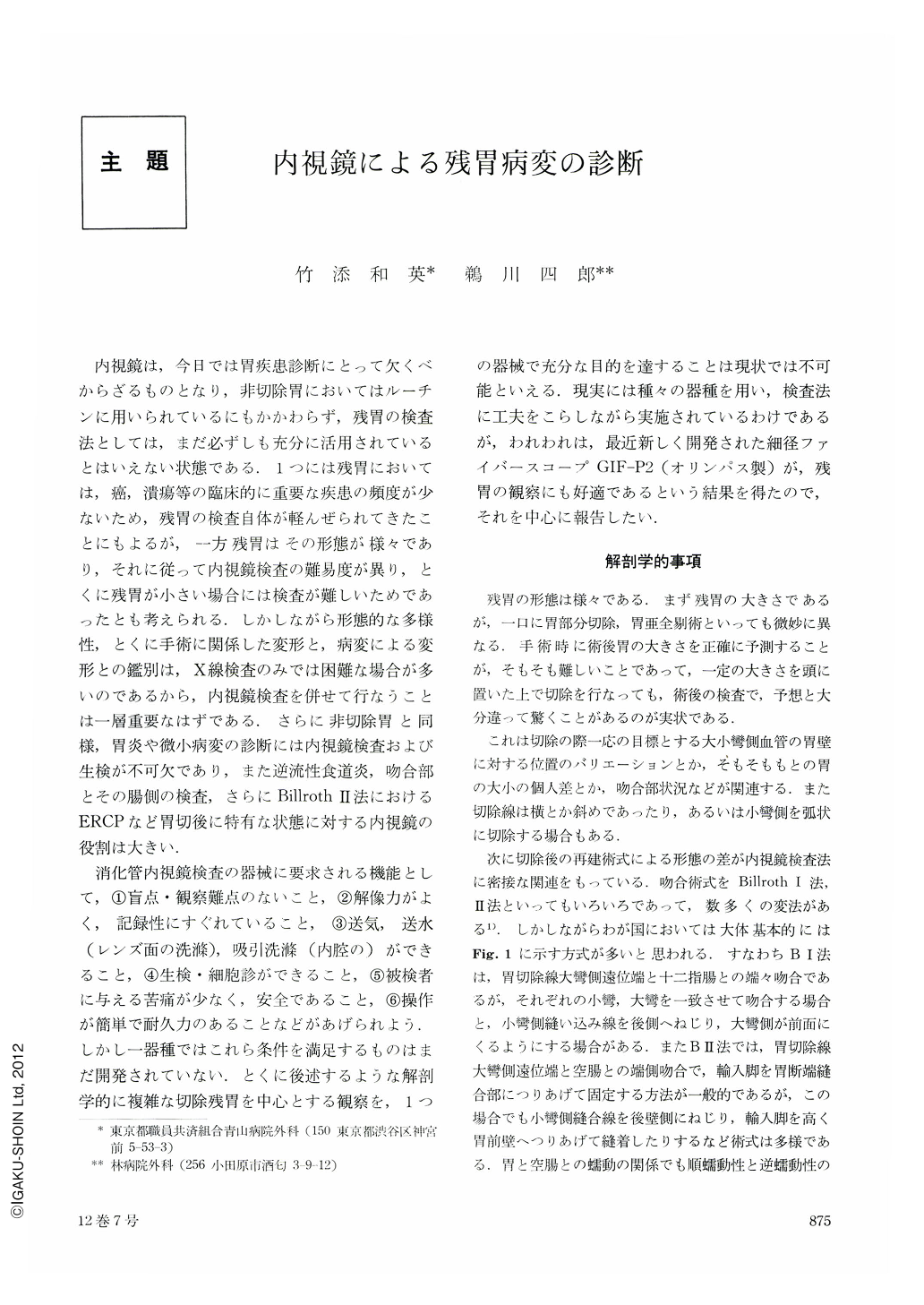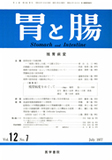Japanese
English
- 有料閲覧
- Abstract 文献概要
- 1ページ目 Look Inside
内視鏡は,今日では胃疾患診断にとって欠くべからざるものとなり,非切除胃においてはルーチンに用いられているにもかかわらず,残胃の検査法としては,まだ必ずしも充分に活用されているとはいえない状態である.1つには残胃においては,癌,潰瘍等の臨床的に重要な疾患の頻度が少ないため,残胃の検査自体が軽んぜられてきたことにもよるが,一方残胃はその形態が様々であり,それに従って内視鏡検査の難易度が異り,とくに残胃が小さい場合には検査が難しいためであったとも考えられる.しかしながら形態的な多様性,とくに手術に関係した変形と,病変による変形との鑑別は,X線検査のみでは困難な場合が多いのであるから,内視鏡検査を併せて行なうことは一層重要なはずである.さらに非切除胃と同様,胃炎や微小病変の診断には内視鏡検査および生検が不可欠であり,また逆流性食道炎,吻合部とその腸側の検査,さらにBillrothⅡ法におけるERCPなど胃切後に特有な状態に対する内視鏡の役割は大きい.
消化管内視鏡検査の器械に要求される機能として,①盲点・観察難点のないこと,②解像力がよく,記録性にすぐれていること,③送気,送水(レンズ面の洗滌,吸引洗瀞(内腔の)ができること,④生検・細胞診ができること,⑤被検者に与える苦痛が少なく,安全であること,⑥操作が簡単で耐久力のあることなどがあげられよう.しかし一器種ではこれら条件を満足するものはまだ開発されていない.とくに後述するような解剖学的に複雑な切除残胃を中心とする観察を,1つの器械で充分な目的を達することは現状では不可能といえる.現実には種々の器種を用い,検査法に工夫をこらしながら実施されているわけであるが,われわれは,最近新しく開発された細径ファイバースコープGIF-P2(オリンパス製)が,残胃の観察にも好適であるという結果を得たので,それを中心に報告したい.
Gastric remnants show virtually unlimited morphological variations, depending on their size, method of resection or anastomosis, adhesions and pathological distortion if present. Additionally, distensibility is restricted at the areas adjacent to anastomosis or suture line and also there are various changes directly related to surgery. These factors make radiological as well as endoscopic diagnosis of post-operative stomach more difficult in comparison with the ordinary stomach examination. However, there are many problems inherent to postoperative stomach such as regurgitation esophagitis, disfiguration of anastomosis, granuloma along the suture line or anastomosis, stomal ulcer, cancer, ERCP in Billroth Ⅱ stomach, etc. Endoscopy is mandatory for dealing with these problems.
In general, requirements for an upper G-I endoscope would include : (1) elimination of blind area without difficulty; (2) high visual acuity and recordability; (3) facility of inflation and washing of the lens, aspiration and washing of the G-I canal ; (4) channel for biopsy and cytology; (5) safety and minimal discomfort to the patient and (6) durability. So far, however, a single instrument cannot fulfil all these requirements.
Preliminary X-ray study of the esophagus, gastric remnants and distal intestines is mandatory for proper selection of endoscopes. At the moment, a combination of forward and side-viewing fiberscopes is required for thorough examination. Our experience most favorably support the combination of GIF type P 2 (Olympus) and JF type B2 or similar one.
The GIF type P 2, a newly developed slender forward viewing fiberscope with acutely angulatable tip, has proved to be quite satisfactory for examination of the upper G-I tract. Since the tip can be bent 180° with a radius of only 1.8 cm, it was found to be most suitable also for examination of gastric remnants. Even in a smaller gastric remnant, U-turn is easily possible, although J-turn may be unsuccessful in patients with subtotal gastrectomy. However, the front view of the upper portion of the lesser curvature near the cardia is frequently difficult to obtain and it may have to be supplemented by other side-viewing apparatus in occasional cases as mentioned previously.
Special care should be paid to differentiation between “the normal variants” and diseases, particularly cancer. Biopsy or cytological study should be readily applied whenever indicated.

Copyright © 1977, Igaku-Shoin Ltd. All rights reserved.


